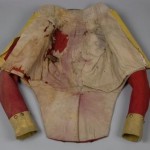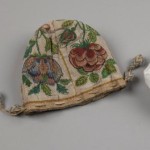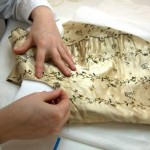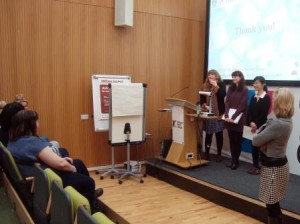
By Alice Young and Rosie Chamberlin, 2nd year students, MPhil Textile Conservation.
As part of the second year Professional Development module, students from the Centre for Textile Conservation (CTC) are invited to take part in a number of public engagement talks. The session has predominantly been developed to enhance the public’s understanding of the work carried out at the Center and also to provide an invaluable opportunity for 2nd year students to present their work to different audiences.
We, along with our fellow 2nd year Moe Sato, visited Glasgow Kelvin College to talk to students studying towards either a BA or HND in Fashion: Design and Production. As a starting point we had been given a brief that the presentation needed to last for approximately half an hour and that the use of a PowerPoint was encouraged. With regards to the content, that was up to us!
Rosie, Alice and Moe presenting their talk Slide one from the PowerPoint presentation The Glasgow Kelvin College Fashion students
In order to plan the presentation we first made a few assumptions about our target audience. Most would probably be in their late teens to early twenties and would have a practical interest in garment construction and design. As a result of this we needed to make the presentation as visually interesting as possible so the use of images of costume and props was decided upon to encourage audience engagement and participation.
Luckily all three of us were working on costume and costume accessories and were therefore able to find a common ground with our audience as we discussed how documentation and conservation is carried out at the CTC. Connections were also made through focusing on the conservation of contemporary fashion. Additionally we introduced the possibility that the student’s designs could in the future, end up in a museum or similar heritage institution, and at some point require a conservation treatment.
Copyright of the University of Glasgow Copyright of the University of Glasgow Copyright of the University of Glasgow courtesy of Dumfries Museum and CSG CIC Glasgow Museums Collection and CSG CIC Glasgow Museums Collection
Current projects
Alice Young – a 19th century military jacket from Dumfries Museum
Moe Sato – a 18th century French beaded purse from Glasgow Museums
Rosie Chamberlin – an 18th century English waistcoat from Glasgow Museums
When planning our talk to the students our initial challenge was to determine how to communicate what it is that we do as textile conservators in training. We found that through presenting the objects that we were currently working on in the form of case studies it became much easier to get this information across, with the addition of the PowerPoint helping to illustrate each aspect of the conservation treatments carried out. By changing our choice of wording for the presentation, that is not using conservation specific terminology eg. saying dirt instead of soiling, we were able to use these objects to present the wide range of activities that being a textile conservator encompasses. The layout of our presentation enabled us to hand out tools and samples of materials we had used for each individual project, this encouraged audience engagement and made the experience we were aiming to portray much more tangible.
Answering questions about the textile conservation profession: much enthusiasm was felt as students asked multiple questions about what they had seen and how they could get onto the CTC course!
This exercise was a great experience on a number of different levels, and it has certainly helped to increase our confidence in talking about the work that we do. The genuine interest and enthusiasm for our projects and the variety of questions asked was very encouraging especially as several of the students that we spoke to came to The Center for Textile Conservation and Technical Art History Open Day.
Engaging with the wider community not only promotes the work of the Center to prospective students but also firmly fixes the CTC within Glasgow. The course’s strong links with Glasgow Museums and other smaller institutions such as Dumfries Museum makes this even more relevant as the objects that we are working on form an important part of the country’s heritage collection.
This was an overwhelmingly positive experience and it was great to share in a small way the conservation of the heritage of Scotland with the future of Scottish fashion design.








